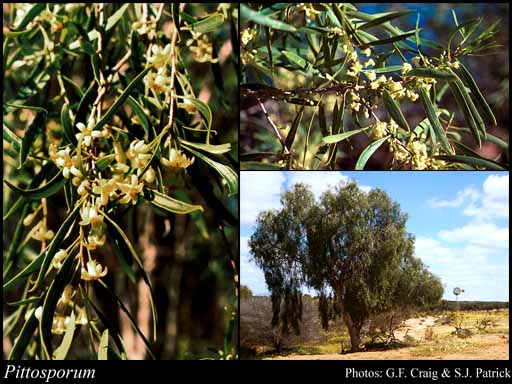- Reference
- Fruct.Sem.Pl. 1:286, t. 59, fig. 7. (1788)
- Name Status
- Current

Scientific Description
Common name. Pittosporums. Family Pittosporaceae.
Habit and leaf form. Trees, or shrubs; evergreen. Plants mostly unarmed, or spiny (occasionally in the smaller branches). To 1–17 m high. Mesophytic. Not heterophyllous. Leaves small to medium-sized; alternate (often crowded into pseudo-whorls towards the end of the branches); spiral; petiolate; simple. Leaf blades dorsiventral; entire (mucronate); linear, or ovate, or obovate, or oblong, or elliptic, or orbicular. Mature leaf blades adaxially glabrous; abaxially glabrous, or pubescent (rarely). Leaf blade margins mostly entire (or undulate), or dentate (rarely).
Reproductive type, pollination. Fertile flowers sometimes functionally male, or functionally female, or hermaphrodite (mostly). Unisexual flowers absent. Plants hermaphrodite.
Inflorescence and flower features. Flowers solitary, or aggregated in ‘inflorescences’. Inflorescence few-flowered to many-flowered. Flowers in cymes, or in racemes, or in corymbs, or in panicles. Inflorescences terminal, or axillary. Flowers bracteate; often fragrant; regular; 5 merous; tetracyclic. Perianth with distinct calyx and corolla; 10; 2 -whorled; isomerous. Calyx present; 5; 1 -whorled; polysepalous; hairy, or glabrous; exceeded by the corolla; persistent, or not persistent. Corolla present; 5; 1 -whorled; polypetalous (coherent at the base to form a more or less definite corolla tube, petals spreading or reflexed from the base); imbricate; regular; hairy abaxially, or glabrous abaxially; hairy adaxially, or glabrous adaxially; plain; white, or cream, or yellow. Petals obovate, or linear. Androecium present. Androecial members definite in number. Androecium 5. Androecial members free of the perianth; free of one another. Stamens 5; all more or less similar in shape; isomerous with the perianth; oppositisepalous; all alternating with the corolla members. Anthers all alike; dehiscing via longitudinal slits; tetrasporangiate. Gynoecium 1 carpelled. The pistil 1 celled. Gynoecium syncarpous; eu-syncarpous; superior. Ovary unilocular (with 2–5 placentas); 1 locular; shortly stipitate, or sessile. Ovary summit glabrous, or hairy, the hairs not confined to radiating bands. Gynoecium stylate. Styles 1; simple; hairless. Stigmas 1; 2–5 - lobed (in functionally female flowers; the stigma hardened in functionally male flowers); capitate. Placentation basal, or parietal. Ovules in the single cavity 30–50 (i.e. many).
Fruit and seed features. Fruit 4–18 mm long; non-fleshy; yellow, or orange (or yellow-brown or red-brown or grey); hairy, or not hairy; dehiscent; a capsule (woody or coriaceous; often compressed). Capsules loculicidal (into 2–5 valves remaining fused at base, bearing placentas along their centre). Dispersal unit the seed. Fruit 1–50 seeded (i.e. 1 to ‘many’). Seeds mucous (immersed in a resinous viscid fluid); compressed (flat, angular); wingless.
Geography, cytology, number of species. World distribution: Australia, South Asia, Africa, West Pacific and Hawaiian islands. Native of Australia. Not endemic to Australia. Australian states and territories: Western Australia, South Australia, Northern Territory, Queensland, New South Wales, Victoria, Australian Capital Territory, and Tasmania. Northern Botanical Province and South-West Botanical Province. A genus of 150 species; 11 species in Western Australia; 0 endemic to Western Australia.
Additional comments. Etymology: from the Greek pitta, resin; spora, seed; alluding to the sticky pulp enveloping the seeds.
Etymology. From the Greek for "pitch" and "seed"; refers to the sticky pulp enveloping the seeds.